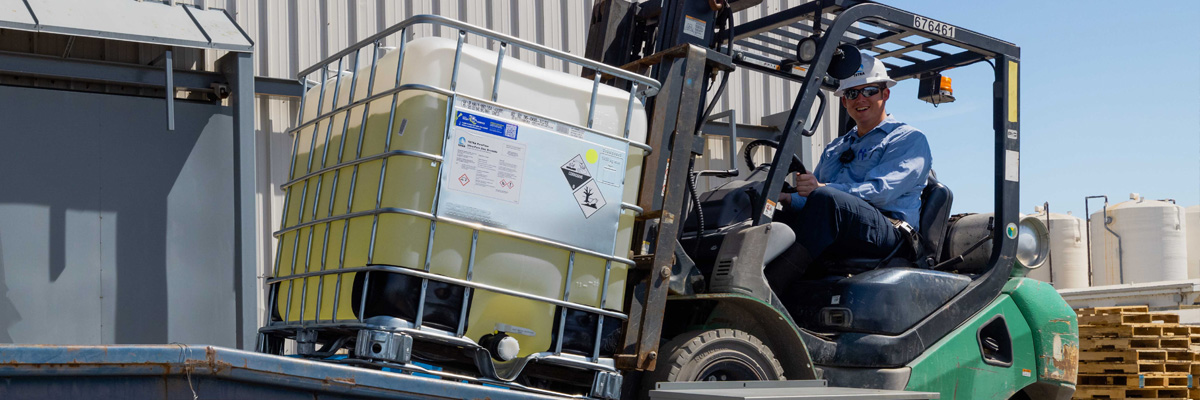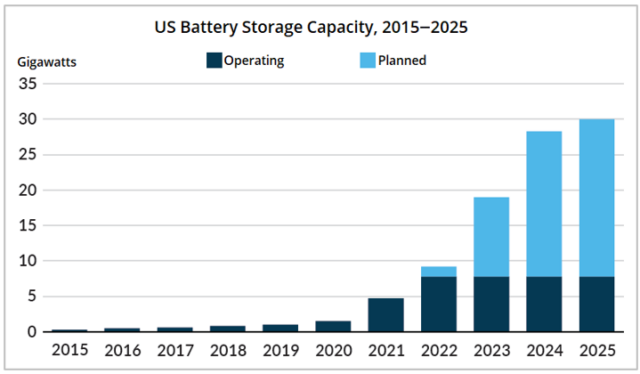Meeting the Challenge of Future Commercial Energy Storage with TETRA PureFlow Ultra-Pure Zinc Bromide
By Archie Vest | Senior Director of Bromines, Chemicals North America | May 4th, 2023

Grid-Scale Power Storage
Power storage is now widely recognized as essential to the reliable delivery of renewable energy and ultimately to the commercial viability of all grid-scale solar and wind installations. These sources of energy are inherently intermittent, dependent as they are on sunshine and wind, and therefore require storage solutions to ‘level’ or ‘smooth out’ the power stream, ensuring consistent delivery of energy over time.[1]
For the most part, grid-scale power storage technologies are either mechanical, thermal, or electrochemical. Mechanical storage solutions dominate infrastructure and include flywheels, compressed-air energy storage, and pumped-storage hydroelectricity, the latter two being the most prevalent.[2] Thermal solutions are typically based on either molten-salt or water, using the stored heat or cold to generate power during off-cycles. Electrochemical solutions include supercapacitors and rechargeable batteries that use either lead-acid, lithium, nickel, sodium-sulfur, vanadium, or zinc.[3]
Lithium-ion batteries are the most well-known rechargeable storage devices, having largely displaced the once-popular nickel-cadmium variety. They are now used in most battery-powered consumer products, from cellphones and notebook computers to power tools and electric vehicles. Lithium-ion also dominates at grid scale, accounting for more than 90% of battery-based grid-scale storage systems in the US in 2018.[4]
Lithium batteries, however, present significant drawbacks for grid-scale storage: first, they’re currently not cost-effective for duration cycles beyond three hours[5]; and second, they pose a high risk of fire, which would be catastrophic in a large, high-density installation.[6] In fact, large lithium-ion battery installations generally require costly fire-suppression systems. Lastly, for the US and EU markets, another concern with lithium is security of supply, as more than 90% of the mineral’s global production occurs in Argentina, Australia, Chile, and China.[7]
The Zinc-Bromide Alternative for Power Storage Batteries
For grid-scale applications, an excellent alternative to lithium-ion batteries for power storage is zinc-bromine flow batteries. Invented in the 1970s, zinc-bromine flow batteries use low-cost, readily available materials, have longer lives, pose little risk of fire as the electrolytes are non-flammable, and provide duration cycles longer than their lithium-ion counterpart.
In fact, with the current proliferation of wind and solar power storage installations, the market for zinc-bromine batteries is growing fast, with several companies now developing and deploying commercial zinc-bromine batteries and building up lengthy backlogs for demand.
To support the fast-growing need for commercial energy storage, TETRA Technologies pioneered its TETRA PureFlow® ultra-pure zinc bromide for use in grid-scale storage systems and solar power battery storage. TETRA believes it is the only producer of commercial quantities of zinc bromide in the United States and manufactures PureFlow zinc bromide using a proprietary process at its chemical plant in West Memphis, Arkansas.
With regard to the security of resource supply, TETRA holds the mineral rights to extensive brine leases in Arkansas that are estimated to contain 5.25 million tons of bromine. The Company is currently completing a detailed geological, reservoir, and production simulation study to determine and ensure a long-term supply of bromide.
The high-purity characteristics of PureFlow zinc bromide make it ideal for large-scale, long-lasting, high-performing battery technologies. To date, PureFlow zinc bromide has been tested and qualified by three separate manufactures of zinc-bromine storage batteries. In 2021, TETRA entered an agreement with Eos Energy Enterprises for collaboration and long-term supply of zinc bromide to support production of Eos’ innovative Znyth aqueous zinc battery. Based in Edison, New Jersey, Eos is a leading provider of safe, scalable, efficient, and sustainable zinc-based long-duration energy storage systems.
The Science of the Zinc-Bromine Battery
There are two types of zinc-bromine batteries, flow and non-flow. As one might surmise, the content of the flow battery is circulated while that of the non-flow type is stationary. Both, however, use zinc bromide as part of the electrolyte. The purity of the zinc bromide is paramount to performance and battery life, and TETRA PureFlow ultra-pure zinc bromide provides some of the highest purities in the industry.
In simplest terms, a zinc-bromine battery stores electrical energy in the charge cycle by plating zinc (Zn) onto a conductive anode plate—typically carbon or titanium—while transforming negatively charge bromide ions (Br¯) into bromine (Br2). When providing power in the discharge cycle, the process is reversed—the zinc plated on the anode dissolves in the electrolyte solution, rendering it available for plating again in the next charge cycle. Energy capacity depends on the size of the electrolyte reservoirs and the anode and cathode electrodes.
The elegance of the zinc-bromine battery is the high energy density, long duration cycles, long life, and recyclability of the electrolyte. The battery can provide high numbers of cycles with little degradation, and when it does expire, the zinc bromide can potentially be reclaimed, renewed, and possibly reused in another battery or for other uses, like completion fluids used in oil and gas wells. In other words, zinc bromine batteries provide the potential for a truly renewable source of energy.

FIGURE 1: The diagram shows a zinc-bromine flow battery, which uses pumps to circulate the aqueous zinc-bromide electrolyte.
Projected Growth for Commercial Energy Storage Batteries
While many projections for the US stationary energy storage market range from 25% to 35% compound annual growth rate (CAGR) over the next 10–15 years—a considerable rate by any measure—the US government’s Energy Information Administration is even more bullish, forecasting US battery storage demand to go from 7.8 gigawatts (GW) in 2022 to 30 GW by 2025—that’s an astounding 57% CAGR over three years.[8]

FIGURE 2: US Battery Storage Capacity in GW, 2015–2025, Operating and Planned. SOURCE: EIA.
The global forecast is even greater. In October 2022, Bloomberg New Energy Finance (BNEF) reported that “Energy storage installations around the world are projected to reach a cumulative 411 gigawatts (or 1,194 gigawatt-hours) by the end of 2030,” marking a 15-fold increase.[9] Most of the growth is expected in the US and China, the two largest markets, but energy storage is now a top infrastructure endeavor on every continent.
The global energy transition is now well underway and accelerating rapidly. Wind and solar energy installations are proliferating around the world and across the United States, and with these installations come the need for grid-scale power storage. Battery storage systems are arguably the most scalable and adaptable of grid-scale power storage technologies, enabling speedier deployment and tighter footprints than, for example, a pumped hydroelectric system that requires expansive real estate and more complex construction.
Of the various battery types for grid-scale power storage, zinc-bromide batteries are one of the best batteries for solar power storage and renewable power projects. And to ensure the long-life and reliability of the batteries, TETRA PureFlow® ultra-pure zinc bromide purity levels provide one of the best choices for battery manufacturers.
Endnotes
[1] EIA, “US Battery Storage Capacity Will Increase Significantly by 2025,” 8 December 2022.
[2] Shin-ichi Inage, “Prospects for Large-Scale Energy Storage in Decarbonised Power Grids,” International Energy Agency, 2009, p. 19.
[3] It should be noted that the pace of innovation in power storage technologies is accelerating rapidly, so this list of solutions, including battery types, is not exhaustive.
[4] EIA, “Battery Storage in the United States: An Updte on Market Trends,” July 2020. See also David Hart and Alfred Sarkissian, “Deployment of Grid-Scale Batteries in the United States,” a report prepared for Office of Energy Policy and Systems Analysis, US Department of Energy, 2016, p. 2.
[5] Chris McKay, “How Three Battery Types Work in Grid-Scale Energy Storage Systems,” Windpower Engineering & Development, 18 March 2019. Also see The Korea Times, “Gov’t Officials Clueless about Cause of ESS Fires,” 2 May 2019.
[6] The Korea Times, “Gov’t Officials Clueless about Cause of ESS Fires,” 2 May 2019.
[7] Govind Bhutada, “Charted: Lithium Production by Country (1995–2020),” visualcapitalist.com, 9 February 2022.
[8] EIA, “U.S. Battery Storage Capacity Will Increase Significantly by 2025,” 8 December 2022.
[9] Veronika Henze, “Global Energy Storage Market to Grow 15-Fold by 2030,” BNEF, 12 October 2022.


